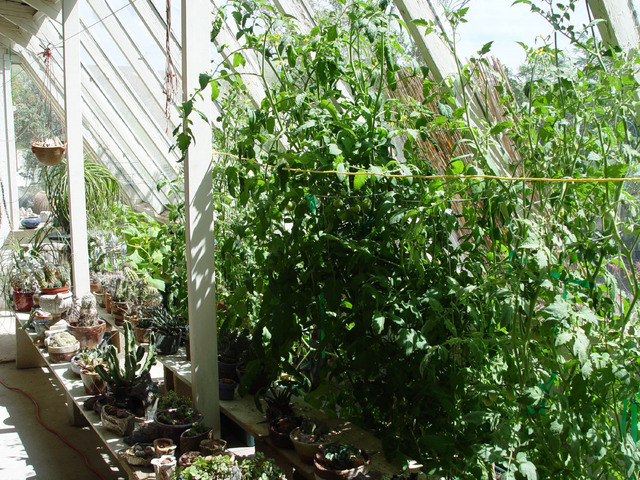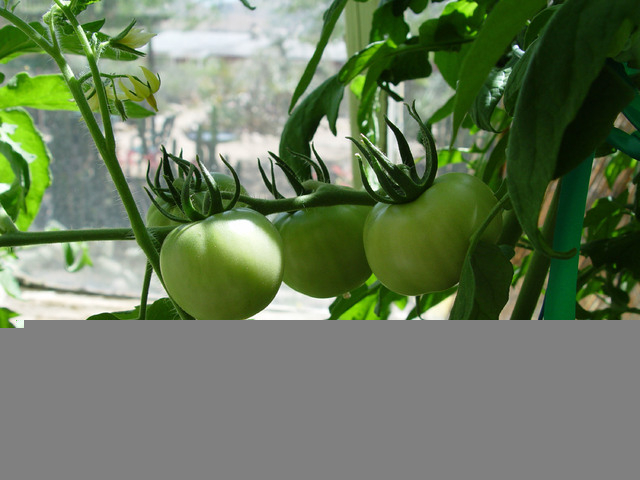Cheat the seasons with self-watering containers
Here in the desert, I needed some last-minute photography for my new book on growing vegetables in drought, but it was too early. So I bought a bunch of self-watering containers to use in my unheated greenhouse to find out if they are as productive here as they are elsewhere.
I started my tomato seeds at the end of January, they went into the containers in late February and in April I had 5-foot-tall burly beefsteaks with large green fruit in my greenhouse. It’s the first year I’ve ever tried to cheat the seasons and so far I’m totally impressed.
I am not keen on growing vegetables in pots, but I had heard a lot about self-watering containers and thought I’d test them while solving my photo problems. The rectangular troughs are different in how plants access water. They blend traditional container gardening with new technology derived from soilless hydroponic greenhouse food production.
As I looked out at the enormous plants that were tiny seedlings just weeks earlier, I couldn’t help realizing how important this growing method is for those in drought. They allow you to harvest clean waste water from the kitchen, bath or shower. I’ve been using leftover water in bottles, glasses and pitchers rather than pouring it down the drain. It’s so easy to step outside and pour it directly into the reservoir, so I use that much less tap water to top it off.
Self-watering containers are super problem solvers tailored to small spaces, apartments or condos, because you can also buy a trellis designed to keep plants upright and tidy. Boxes also can be used on a tabletop for those with disabilities, and they’re the cure for everyone who lacks a green thumb. All that’s required once planted is to simply train vines and fill the reservoir except, of course, to pick ripe fruit.
There are two competing brands that make nearly identical self-watering containers: EarthBox, available online from EarthBox.com, and GrowBox, available at AGardenPatch.com. EarthBox is the original developer of the green technology, while GrowBox came later with some minor design differences.
The EarthBox reservoir is filled from the top through a standpipe, and they’re available in different colors. GrowBox fills from a slot lower on one side, and the reservoir is larger, about 4 gallons. The fill hole allows me to insert a finger like a dipstick to assess water levels. Both brands offer accessories such as trellises designed specifically to fit the boxes, handy wheels for the bottom to allow movement and many other add-ons and handy helpers for various crops.
I reserved one box for growing my favorite white apple cucumbers, and the Beit Alpha type developed in Israel for greenhouse hydroponic cultivation. Both share the same box and are flowering like crazy, yielding plenty of fruit. I created a homemade grid trellis for the plants that thrive under glass and will soon be enjoyed in salads along with the tomatoes.
Because self-watering containers are sold online, they’re a great gift idea, particularly if you live far from the recipient. Once the box arrives, all they need to get started is a large bag of potting soil and locally sourced plants.
You don’t need new potting soil for replanting next year, but you will have to buy a fresh nutrient pack from the same website. While you’re there, take a look at gallery images of the many types of vegetables people are growing in the containers.
Where drought is limiting your options in the garden, rethink how you use waste water or not. Take advantage of desert agriculture’s hydroponic solutions to feed the world by joining this revolutionary way of gardening. It asks for little space, less water and almost no care, so you can grow everything in the most unlikely places, as long as there’s enough sun to ripen a tomato.
Maureen Gilmer is an author, horticulturist and landscape designer. Learn more at www.MoPlants.com. Contact her at mogilmer@yahoo.com or P.O. Box 891, Morongo Valley, CA 92256.


















